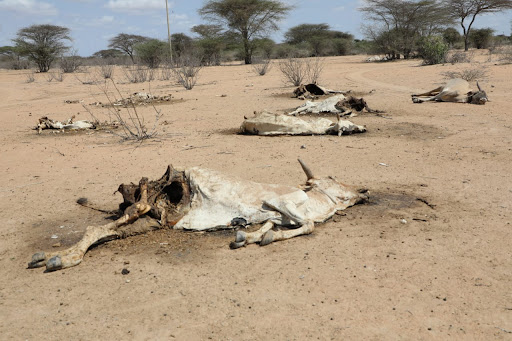 In Kenya, drought effects are felt most acutely in arid regions such as Kajiado, Tsavo, and Laikipia.
In Kenya, drought effects are felt most acutely in arid regions such as Kajiado, Tsavo, and Laikipia.A new UN-backed report has sounded an alarm over dangers facing Kenya’s wildlife.
The Drought Hotspots Around the World 2023–25 report, released by the US National Drought Mitigation Center and the UN Convention to Combat Desertification, warns that prolonged droughts, caused by global warming and compounded by human pressures, are destroying animal populations.
The report identifies eastern and southern Africa as some of the worst-hit regions, where fragile ecosystems have begun to collapse under the weight of climatic and human stress.
In Kenya, the effects are being felt most acutely in arid regions such as Kajiado, Tsavo and Laikipia, where wildlife is increasingly coming into conflict with communities battling their own survival.
One incident highlighted in the report occurred in June 2023, when six lions were speared to death by herders in Kajiado county after they killed a dozen goats. The lions had strayed from Amboseli National Park, driven by hunger and thirst into human settlements.
“The Maasai herder, who lost half his livestock, said the compensation offered would not replace his economic loss.” Historically, the Maasai have lived in harmony with lions, but drought has pushed man and beast into new and dangerous territory.
El Niño’s return in 2023 led to a global temperature surge, with Kenya experiencing extreme drought conditions that have persisted into 2025. Water sources in Tsavo East and West National Parks have dried up, forcing elephants and predators into nearby villages in search of food and water. These encounters often end in violence, as communities, already facing hardship, respond with lethal force.
Dr Henno Havenga of the Unit for Environmental Sciences and Management at North-West University in South Africa offers a broader ecological explanation.
“Human-animal interactions are becoming more complex due to climate change, but we must remember that we’ve fundamentally altered animals’ natural migrations,” he said. “Droughts have always occurred, but in the meantime, we’ve put up fences at every turn. Where elephants once migrated thousands of kilometres in search of food and water, they are now trapped in fixed reserves.”
Havenga warned that this restriction “turns survival into conflict,” explaining that when animals can no longer migrate, they inevitably come into contact with humans. “It rarely ends well for the animal,” he said.
Although some animals die directly from drought, especially the old or sick, many are killed due to their proximity to humans. “Most of the deaths aren’t simple acts of nature,” he cautioned, “but the result of conservation systems pushed to breaking point.”
The report also draws comparisons with regional neighbours. In Zimbabwe, more than 100 elephants died in late 2023 when drying watering holes became deadly mud traps. The situation led to the controversial culling of 200 elephants, a move justified by the government due to the population exceeding sustainable capacity. Namibia followed suit with plans to cull more than 600 animals, including zebra, buffalo, impala and hippos.
In Kenya, conservationists and community leaders now face the daunting task of balancing wildlife preservation with human livelihood. The report’s authors warn that without urgent reform—including the restoration of migratory corridors and investment in drought resilience—people and wildlife will continue to suffer.
As climate shocks become more frequent, the cost of inaction may prove catastrophic. The survival of Kenya’s iconic species and the communities that have long coexisted with them now hang in a delicate balance.











